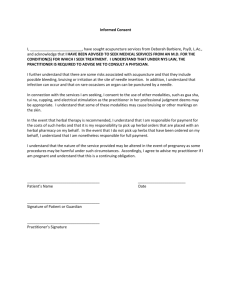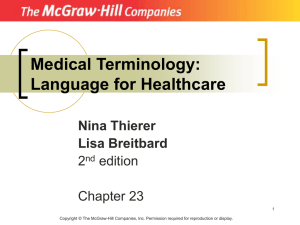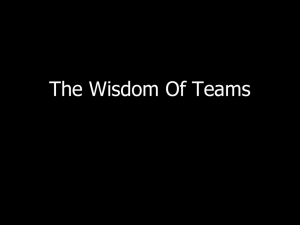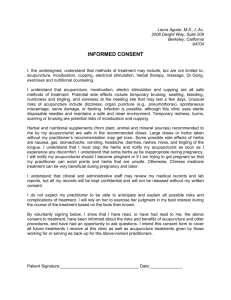hw499 week 5 assignment ashley harris
advertisement
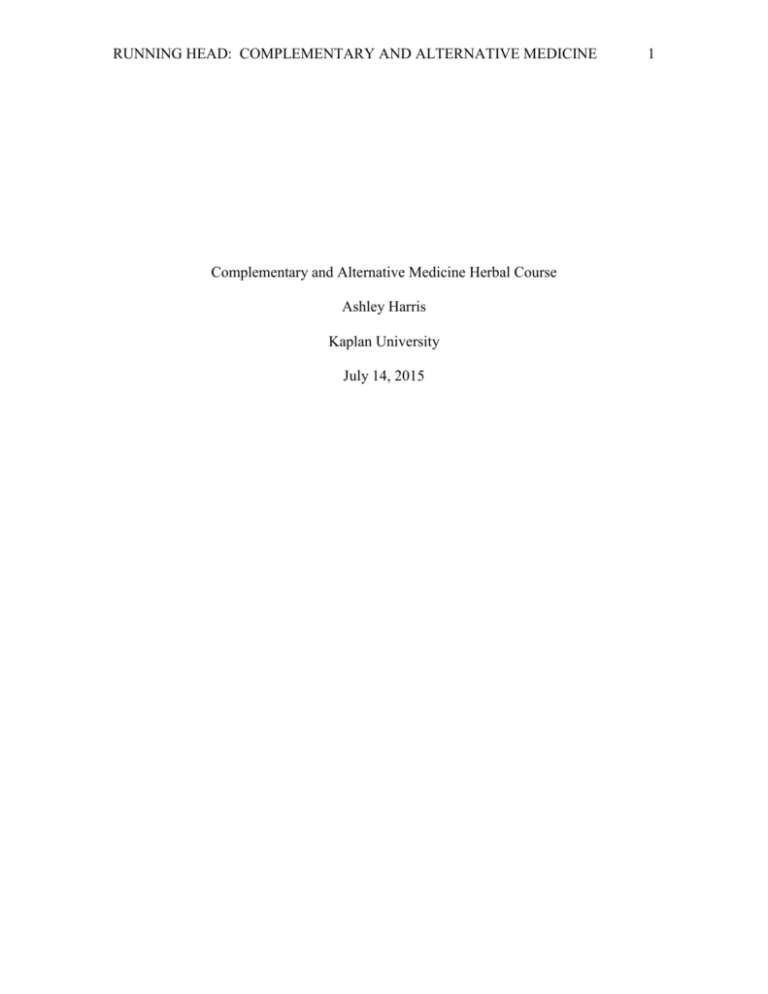
RUNNING HEAD: COMPLEMENTARY AND ALTERNATIVE MEDICINE Complementary and Alternative Medicine Herbal Course Ashley Harris Kaplan University July 14, 2015 1 RUNNING HEAD: COMPLEMENTARY AND ALTERNATIVE MEDICINE Complementary and Alternative Medicine Course Course Syllabus General Information Instructor: Ashley Harris Email: ashlea1908@yahoo.com Course Meetings: Online, Wednesday @ 6pm CST Credit Hours: 3 Course Description This course introduces the field of complementary and alternative medicine (CAM). An introduction to CAM, an introduction to herbs, the interactions herbs have with other medicines, and information on how to select a qualified a CAM practitioner are all are presented in this course. Course Prerequisites None Course Objectives 1. To understand the basics of complementary and alternative medicine. 2. To learn what herbs are. 3. To understand the good and bad of herbs in conjunction with medicine. 4. To learn side effects and interactions of herbs. Required Course Materials Internet Access 2 RUNNING HEAD: COMPLEMENTARY AND ALTERNATIVE MEDICINE 3 Recommended Course Materials Duke, J. (1987). Handbook of medicinal herbs. CRC Press. Retrieved from http://www.amazon.com/dp/0849336309/ref=as_sl_pd_tf_lc?tag=umaatantra20&camp=14573&creative=327641&linkCode=as1&creativeASIN=0849336309 &adid=1NX8906KB3RT7MV42S6T&&ref-refURL=http://acameducation.com/about-a-cam/recommended-reading/ Grading Timetable All assignments will be due by midnight Tuesday of each unit. Grades will be posted within four days of assignment due date. Late work not accepted after day seven without prior arrangements with instructor. Grading Criteria Grades will be administered on a 4.0 grade point scale. RUNNING HEAD: COMPLEMENTARY AND ALTERNATIVE MEDICINE Handout Material Phase I Complementary and Alternative Medicine Definition Difference between complementary versus alternative Different types of CAM Phase II Introduction to Herbal aspect of CAM What are herbal remedies in relation to CAM Positive and negatives of herbal supplements Finding the right supplement to fit individual needs Phase III Finding the right CAM practitioner 4 RUNNING HEAD: COMPLEMENTARY AND ALTERNATIVE MEDICINE 5 Lecture Phase I summary: Phase I defines what Complementary and Medicine is as well as the difference between complementary and alternative. Phase I concludes with different types of CAM. Phase I details Complementary and alternative medicine, also often referred to as CAM, is a specific type of medicine that includes a variety of treatment approaches that are outside the scope of what we consider traditional medicine. Per National Center for Complementary and Integrative Health, more than 30 percent of adults and about 12 percent of children use health care approaches developed outside of mainstream Western, or conventional, medicine. When describing these approaches, people often use “alternative” and “complementary” interchangeably, but the two terms refer to different concepts: If a non-mainstream practice is used together with conventional medicine, it’s considered “complementary.” If a non-mainstream practice is used in place of conventional medicine, it’s considered “alternative. (NIH, 2015). Complementary versus alternative differences Complementary medicine is when traditional medicines are used parallel to healing practices. For example, a person may be diagnosed with cancer and is being treated with chemotherapy. However, the person may have extreme nausea and vomiting. The person may opt for meditation, aromatherapy, or acupuncture to relieve nausea symptoms in conjunction with chemotherapy. RUNNING HEAD: COMPLEMENTARY AND ALTERNATIVE MEDICINE 6 Alternative medicine is the opposite. Instead of using the medicine in conjunction with traditional medicine, it is used as a replacement for traditional medicine. A perfect example is a person who decides to go vegan and eat raw fruits and veggies only to fight the cancer instead of using chemotherapy. Different Types of CAM According to NIH, there are several alternatives available that fall under CAM. Mind and body practices such as acupuncture, yoga and tai chi are very popular. There is also homeopathy, Chinese medicine practices, etc. Herbs are another CAM method that will be discussed in this lecture. (2014 National Health Center) RUNNING HEAD: COMPLEMENTARY AND ALTERNATIVE MEDICINE 7 Phase II Summary: Phase II defines herb and the pros/cons of taking herbs. Phase II Details Herbs Medline Plus defines an herb as a plant or plant part used for its scent, flavor, or therapeutic properties. Herbal medicines are one type of dietary supplements. They are sold as tablets, capsules, powders, teas, extracts, and fresh or dried plants. People use herbal medicines to try to maintain or improve their health. Herbal medicines contain some form of herbs whether it is preparation of herbs or the end result of a product. This could be in the form of a plant, materials from a plant, or a combination of both. Herbs are used as therapeutic activity and have proven to be successful in regards to diagnosis, treatment of illnesses, and prevention of illnesses. Herbs have also been proven to reduce symptoms of illness, and regulate the physical and mental status of the human body. Herbal supplements are not meant for everyone. Complication can arise if a persona suffers from allergies or is taking medication that will have an adverse reaction to the two combined. It is highly recommended to consult with a CAM practitioner or physician before starting an herbal regimen. Phase III Summary: Choosing the right CAM practitioner is key to successful alternative treatments. It is recommended to ask for credentials and references when selecting a CAM practitioner. RUNNING HEAD: COMPLEMENTARY AND ALTERNATIVE MEDICINE 8 Phase III Details CAM Practitioners come a dime a dozen. In order to receive the most successful treatment and optimize results, it is imperative one finds the right practitioner to fit one’s needs. The following needs to be taken into consideration when searching for the proper practitioner: Licenses Certifications Education Do not be afraid to ask for qualifications, proof of certifications, referrals, etc. Ask a traditional physician for a referral if necessary. NIH has excellent tips on how to select a proper provider (details below): 1. If you need names of practitioners in your area, first check with your doctor or other health care provider. A nearby hospital or medical school, professional organizations, state regulatory agencies or licensing boards, or even your health insurance provider may be helpful. Unfortunately, the National Center for Complementary and Integrative Health (NCCIH) cannot refer you to practitioners. 2. Find out as much as you can about any potential practitioner, including education, training, licensing, and certifications. The credentials required for complementary health practitioners vary tremendously from state to state and from discipline to discipline. Once you have found a possible practitioner, here are some tips about deciding whether he or she is right for you: RUNNING HEAD: COMPLEMENTARY AND ALTERNATIVE MEDICINE 9 3. Find out whether the practitioner is willing to work together with your conventional health care providers. For safe, coordinated care, it’s important for all of the professionals involved in your health to communicate and cooperate. 4. Explain all of your health conditions to the practitioner, and find out about the practitioner’s training and experience in working with people who have your conditions. Choose a practitioner who understands how to work with people with your specific needs, even if general well-being is your goal. And, remember that health conditions can affect the safety of complementary approaches; for example, if you have glaucoma, some yoga poses may not be safe for you. 5. Don’t assume that your health insurance will cover the practitioner’s services. Contact your health insurance provider and ask. Insurance plans differ greatly in what complementary health approaches they cover, and even if they cover a particular approach, restrictions may apply. 6. Tell all your health care providers about all complementary approaches you use and about all practitioners who are treating you. Keeping your health care providers fully informed helps you to stay in control and effectively manage your health. (NIH, 2015). Lecture Wrap UP RUNNING HEAD: COMPLEMENTARY AND ALTERNATIVE MEDICINE References Duke Integrative Medicine. (n.d.). What is integrative medicine? Retrieved from http://www.dukeintegrativemedicine.org/about-us/what-is-integrative-medicine Complementary, alternative, or integrative health: What’s in a name?. (2015, March ). Retrieved from https://nccih.nih.gov/health/integrative-health Herbal medicine . (2015, July). Retrieved from http://www.nlm.nih.gov/medlineplus/herbalmedicine.html 10
